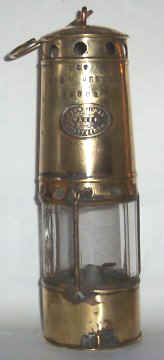
An Obscure Type of Early Twentieth Century Welsh Miner's Lamp
Collectors of miner’s lamps are undoubtedly familiar with most models of safety flame lamps manufactured by the major companies who were prominent from about the mid 1800’s onwards. For collectors of more specialised lamps, there are open flame lamps such as carbide lamps, and the ‘Peg and Ball’ and ‘Midge’ type of oil lamp amongst others. Items such as these were often made specifically for local drift or slant mine use where there was comparatively less risk of explosive gas being present. Except for the carbide lamps, many of these were made by local tinsmiths, often to a high standard of workmanship. However, due to their comparatively fragile nature and tendency to rusting where tin was used rather than brass, their survival rate has been low.

Figure
1 : A
Pontyberem type miner's lamp.
Typical
Pontyberem lamps have an overall thin brass carcass, the height to the top of
the copper loop for the lamp hook is 210mm and the width of the base is 70mm.
There are either 12 air holes of 6mm diameter above the glass at the base of
the bonnet and 9 holes below the top of the bonnet of 8mm diameter, or 11 air
holes of 7mm diameter above the glass and 8 holes of 9mm below the bonnet.
Two
varieties of this lamp have been found. One has a removable base integral with
the oil vessel and burner as shown in Figure 2 below.
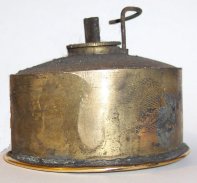
The
other has a removable carcass as a base to hold a candle as shown in Figure 3
below.
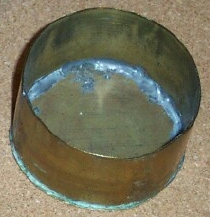
The glass
is fixed in both varieties; the top resting against a flange, whilst the base
of the glass is secured to the bonnet by solder (See Figure 4).
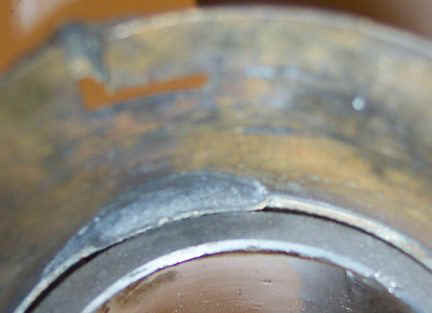
Figure
4 : Pontyberem Lamp -Detail showing glass secured to base of
lamp's bonnet with solder.
Within
the top of the lamp below the air holes, there is a circular piece of
perforated tin or zinc soldered on to a flange. Quite what purpose this
perforated plate (shown in Figure 5 below ) serves is not clear. With an
aperture size of approximately 1.5 mm it is unlikely to have been intended as
a flame arresting device as the inner wire gauze cylinders do on more conventional
flame safety lamps .
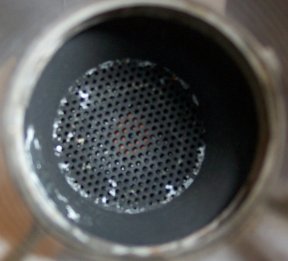
Figure
5 : Pontyberem Lamp -Detail showing the inner perforated plate
inserted below the air holes in the top of the bonnet.
All
types of Pontyberem Lamp so far recorded have three brass pillars, soldered at
both ends, and all have an oval nameplate soldered to the bonnet (see
Figure 6 below) bearing
the following legend: JOHN JONES / -·-
/ MAKER / -·-
/ PONTYBEREM :
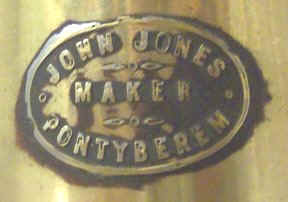
Figure
6 : Pontyberem Lamp -Detail showing maker's name plate.
The
nameplates appear to be embossed, but a close examination shows that they are
made from brass foil and are bracteate. This can be seen below in Figure 7.

One
lamp has received much cleaning, so that parts of the brass plate lettering
has worn away sufficiently to expose the solder below. This gives the
impression that the plate has been stamped as can be seen below in Figure 8.
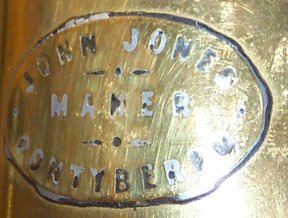
The
lamps appear to have been made to a continuing pattern, with the maker’s
number, the name of the purchaser, and the year of purchase stamped on the
bonnet above the nameplate. Three of the lamps have also what is probably the
owner’s town of residence. Two are stamped Mynyddygarreg (near Kidwelly),
and one is stamped Glyn Abbey (near Carway). Those that are not marked with a
place name may indicate that the purchaser lived in Pontyberem. It is not
certain if the maker’s number refers to the number of the lamp manufactured
sequentially, or the lamp as it was bought - or made to order.
From
the lamps that have so far been recorded, the following information can be
appended:
| YEAR | NUMBER ON LAMP | TYPE |
| 1900 | --- | Candle |
| 1901 | 95 & 115 | Wick |
| 1902 | 267 | Wick |
| 1904 | 556 | Candle |
| 1906 (See Addendum) |
876 |
Wick |
| 1907 |
1128 |
Wick |
| 1909 | 1394 | Wick |
| 1911 | 1671 | Wick |
| 1912 | 1792 | Wick |
| 1913 | 1857 | Wick |
| 1923 | 2354 | Candle |
Of
course, there are exceptions to the observations made above. The first lamp
has no number, which would probably have confirmed 1900 as being the year that
John Jones commenced making lamps, or at least numbering them. There is also a
lamp that carries only the maker’s plate, and no additional information.
From
the average number of lamps made during the periods marked by years, 1901-1902
produced 152 lamps; 1902-1904 produced 289 (145 per year); 1904-1907 produced
567 (189 per year); 1907-1911 produced 453 (113 per year); 1911-1912 produced
121; 1912-1913 produced 65 and 1913-1923 produced 497 (50 per year).
Pontyberem,
situated in the Gwendraeth Valley in Carmarthenshire, was centrally situated
to take full advantage of the area’s anthracite seams that could be accessed
by slant or drift. Lawrence (1) notes that Pontyberem Colliery opened in 1845,
and that Clynhebog and Pentremawr (as Capel Ifan 1, 2, 3, and 4 Slants) were
being worked. Glyn-Yr-Hebog Drift Mine was operational between 1892-1915 (2).
In 1913 these mines, all at Pontyberem, employed some 1,300 workers.
Certainly,
John Jones commenced his local lamp business at an appropriate time. However,
from 1913 there was a gradual decline in the Pontyberem Colliery workforce
(1). Also the 1911 Coal Mines Act began to take effect making safety lamp
regulations stricter – though these were probably less regarded for quite
some time in the Anthracite area. But in 1924, the owners came under the
control of the United Anthracite Collieries, and then in 1926 the Amalgamated
Anthracite Collieries. Pontyberem as one result of these changes of control
merged with Clynhebog (Glynhebog). Although by then, despite the changes the
overall mines workforce in the areas had not declined, employing some 1,500
workers (3). It appears likely that by then the use of safety lamps had been
more generally enforced, and that John Jones would have ended his lamp making
around 1925.
From
an appraisal of his lamps that have been recorded, it is surprising that only
two out of nine have cracked glasses. Three soldered pillars are little
protection against damage, particularly if the glass is under stress from heat
at the same time. Additionally one lamp (No. 115) was damaged sufficiently to
have required a replacement glass – which is an Ackroyd & Best
‘Hailuxo’ type. As this replacement glass is smaller than the original, a
metal retaining ring had to be made and soldered in position. This ring, made
from an early electric lamp shows clearly a Ceag logo – both items dating
the damage to around 1910-1912 (shown below in Figure 9).
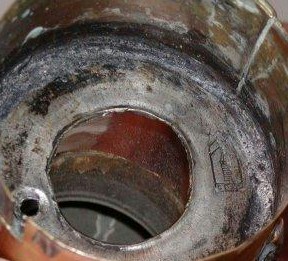
The
owner of the lamp appears not to have commissioned John Jones to undertake the
repair, who would surely have replaced the correct glass.
I
had hoped to obtain information regarding John Jones, but searches through
Trade Directories of the area from 1900 – 1925 were negative for his name as
a Tinsmith, Ironmonger or Lamp maker. The 1901 census online (4) does not
return ‘Pontyberem’ when entered, though a broad search gave a number of
John Jones’ listed as ‘coal hewers’ with several more working in a local
tinworks near Kidwelly. There is therefore a possibility that our John Jones
worked at a tinworks and used these skills also at home. Glamorgan Family
History Society informed me that as Pontyberem straddled several Parishes, it
would take some considerable time to research. So there are more
‘possibles’, ‘probables’ and ‘maybes’ left than I had anticipated
when commencing this article. Certainly, the title remains an accurate
description!
Maybe
someone living locally might at some time be able to consult the 1901 census
returns for Carmarthenshire that are available on twelve CD-ROM’s (5) or
probably also, on microfiche at Carmarthen Record Office.
I shall indeed be interested to learn any further information regarding John Jones and his lamps.
Grateful
acknowledgements to the owners of the lamps mentioned for their lamp details,
and to the owner of lamp No. 556 who kindly provided me with photo (Figure 3) of the
lamp’s candle type base. Information was given also by Emyr George and
Graham Smith.
(1) Lawrence, R. South Wales Coalfield Directory Vol. 2. (Blackwood, S. Wales, 1998 edition, Private publication).
(2)
Owen, David. South Wales
Collieries Volume 3. (Stroud, Tempus Publishing, 2002).
(3)
Colliery Year Book and Coal Trades Directory (London, 1925).
(4)
http://www.census.pro.gov.uk/
(5) http://www.CarmarthenshireFHS.co.uk
Based on an article in NMMA Newsletter No.30, Spring 2003. © David Shaw.